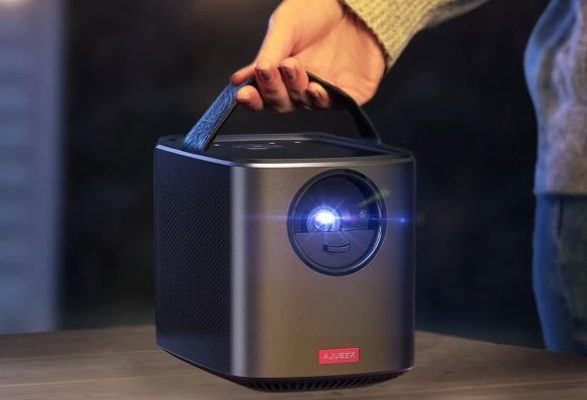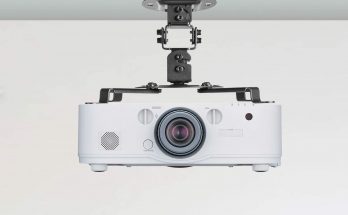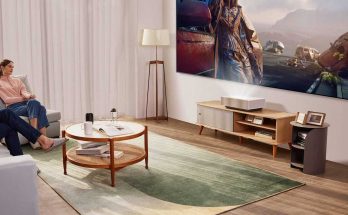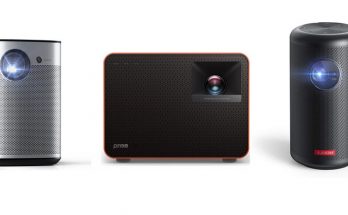You don’t need to spend thousands of dollars buying a large projector if you want to watch high-quality video content on a big screen. We’ve picked out some of our favorites for the Best Portable Mini Projector.
Quick Comparision
| Image | Product |
|---|---|

|
Best mini portable projector overall: Anker Nebula Mars II Pro Editor's Rating: 9.8 Brand: NEBULA Check Price |

|
Best 1080p portable projector: BenQ GS50 Editor's Rating: 9.7 Brand: BenQ Check Price |

|
Best cheap mini portable projector: AAXA P8 Editor's Rating: 9.6 Brand: AAXA Technologies Check Price |
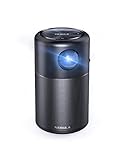
|
Best cheap mini projector with a battery: Anker Nebula Capsule Editor's Rating: 9.4 Brand: NEBULA Check Price |

|
Best cheap projector runner-up: Vimgo P10 Editor's Rating: 9.3 Brand: VIMGO Check Price |
Best Portable Mini Projector for 2022
Our favorite portable projection system here is the Mars II Pro because of its light intensity, overall picture quality, ease of use, and affordable price. It's slightly larger than some other portable projectors here but still compact enough to fit into a six-pack of soda cans.
The Mars II has an internal battery capacity of 12,500 mAh (milliamp hours) and lasts up to three-and-a-half hours when used solely as a Bluetooth speaker. It has apps preinstalled that allow you to stream movies from the device’s internal storage to the screen via Wi-Fi. You can also use the Mars II as a portable media player by downloading music files to the device’s 8 GB internal storage. The faux leather case also makes it easier to carry the device around.
Some product details
- Brighter is Better: DLP IntelliBright technology projects a radiant 500-ANSI-lumen image at razor-sharp 720p for breathtaking video clarity. (Recommended for use in dimmer environments.)
- Expand Your Entertainment: Plug and play your favorite HDMI and USB 2.0 devices, including laptops, PlayStation 4, Xbox One, Nintendo Switch, and more.
- Cinematic Sound: Dual 10W audio drivers work together to deliver sensational sound and deep, resonant bass for a truly immersive outdoor projector movie experience.
- Good color quality for video and photos
- Doubles as a Bluetooth speaker system
- Runs Android 7.1 (and Android apps)
- Loud sound system with smooth audio
- Built-in battery
- Not as easily portable as some similar projectors
- Autofocus is slow to engage
BenQ calls the GS50 an outdoor projection system. That doesn't necessarily rule out indoor use, but it does suggest it's not intended for regular usage in smaller rooms. In particular, it lacks the IP rating needed to withstand the occasional light rainfall indoors. The GS50 can handle drops of up to two feet, though, so it should be fine if you're worried about things falling off shelves. And the GS50 comes with a built-in speaker system, which is nice for watching movies outdoors. The more expensive and bright Epson EF12 remains the best overall choice for the category. It's got better water and drop resistance, plus it's brighter and higher-res, and it includes a USB port for easy charging. But the GS50 still offers a 1080p display, Android TV support, and decent audio performance.
BenQ rates the projection system at 500 ANSI luminescent units. As is customary, the brightest color mode exhibits a clear green tint, so you'll probably only want to utilize it when you must display the brightest images possible. Additionally, this unit drops automatically into low power mode when transitioning to battery power, which likewise decreases the level of illumination. You can return to eco or normal mode if you'd rather, however, the battery will not hold a charge for nearly as long. BenQ does not provide any information regarding battery lifetime in eco or normal power mode.
Some product details
- POWER DELIVERY 45W: Maximize portability and extend play-time with a PD-enabled power bank.
- WORRY-FREE DURABLE DESIGN: IPX2 splash-proof and 2.3ft (70 cm) drop-proof for rugged active lifestyles.
- 2.1 CHANNEL AUDIO W/EXTRA BASS: 2.1 Channel Bluetooth Speaker with Extra Bass (5Wx2 midrange tweeters & 10W woofer).
- 1080p resolution
- 500 ANSI lumen rating
- Acceptable color accuracy
- Impressive audio quality and volume
- Included Android TV dongle for streaming and Chromecast
- Durable and water-resistant
- No 3D support
- The brightest mode has an obvious green tint
- Awkward setup for Android TV dongle
Compared to most of the other projector models on this list, the AAXA P9 isn't able to operate on batteries, but it's so small and inexpensive, that it's still worth considering. There are certainly cheaper projector models available, but none we've tested that offer better performance for their size and cost than the AAXA P7.
The P8 is about the same width as the Anker Capsul, but much longer. Its shape is similar to the Anker capsule, but it's not quite so small. It's also much brighter than the Anker capsule. It comes with a USB charger and has a couple of streaming services preloaded. I'm not really impressed with the picture quality, but it's definitely better than the Anker capsule, and it's one of the cheapest options out there.
Some product details
- [PORTABLE ENTERTAINMENT SYSTEM] - Take this projector anywhere and project up to 200" images. With the built in Android 10 OS, you can wirelessly mirror your phone to the P8 and share videos, pictures, and more!
- Note: The USB port is for flash drive media playback and cannot be used to transmit video signal from smartphones or connect to smartphones. Mirroring requires connection to WiFi.
- [WIDE RANGE OF CONNECTIVITY] - allows you to connect your favorite devices via HDMI, USB-C Input. Direct file playback with USB flash drive and microSD card. Connect to external speakers via 3.5mm or Bluetooth
- Built-in streaming, using Android 10 (not Android TV)
- Comes with apps for Netflix, YouTube, Tubi, and more
- Only 8.8 ounces
- Inexpensive
- No onboard battery
- Measly 950-by-540-pixel resolution (quarter HD)
- No 3D support
- Marginal quality for photorealistic images
The Anker Nebula capsule is smaller than a can but can make a large picture. Not really "large", but "television sized". It's not very bright, nor loud, yet for something so small it's great. Other options here are much brighter and better quality, but if the size is what you're after, the Anker Nebula is better than you might think for its cost and size.
Some product details
- 360° Speaker: Equipped with a powerful omnidirectional speaker, this mini projector pumps out sound all around.
- Android 7.1: Run streaming and media apps flawlessly. Seamlessly display content from Netflix, Youtube, and more on your mini projector for endless entertainment.
- NOTE: Copyrighted content from Hulu, Netflix, and similar services CAN NOT be mirrored or screencast. Download and use the apps directly through Capsule portable projector to view copyrighted content from these providers. Chromecast is not supported. For peak performance, please update to the latest firmware.
- It feels well-built
- Small enough to take anywhere
- Runs Android 7.1
- Must be mounted on a tri-pod if projecting upward at all
- Isn't very bright
- No Google Play Store
- Expensive
The Vimto P10 has an MSRP of $170-$270, which puts it in the same range as the cheapest of our top three picks, the AAXA Projection P8. It's significantly bigger than the P8, though, so it's not quite as portable.
Picture quality is better on the P10 than the P8 in almost every way. The P10 has a higher resolution display, better picture clarity, better colors, and much greater brightness. The only thing I can say about the P8 is that it's a good camera phone.
But the cost is. A perfectly watchable image for around $250, it even has Netflix built in! The main downside is that like the P8, its battery runs out quickly.
Some product details
- Package Include: Remote Control x1, P10 Projector x1, Instruction manual x1, Power Adapter x1. (Not include projector screen and HDMI wire.) The dimension of the projector is about 8.1"x7.3"x5.1". Note: If you have missed any parts or received the broken item in the package, NEED NOT to return, we will send a new one to you.
- [Remote Control Correction] Wifi projector provides a 40-120 inches display, 4-12ft projection distance. Zoom function supports the screen size from 100% to 50% to fit your screen. Adjust the focus and keystone correction until the image is clearer and sharper, keystone correction is one-step to operate, and allows ±50° horizontal, vertical, and rotate adjustment. (Please adjust the screen size to fit your screen, then focus the screen display, and finally perform keystone correction.)
- [User-friendly Design] Video projector is fitted with a modern design, uses raw materials with premium quality. An efficient cooling system and sealed optical engine design, avoid dust from entering inside the machine and reduce 80% noise, extend the projector's life span. 100,000-hour LED Lamp-Life, using diffuse projection to protect eyes, ensures you and your families can enjoy this outdoor projector decade of Worry-Free Entertainment.
- SMART capabilities so you don’t need to stick a Chromecast or Fire stick into the projector to watch things. You can play it directly on the projector which runs Android OS.
- Bluetooth so you can connect your speaker of choice.
- A remote so you don’t need to get up and fiddle with the projector every time you want to make a change. FYI it runs on 2 AAA batteries that aren’t included.
- Autofocus on remote
- 1 USB port
- The design. The projector is small, pastel blue, and aesthetically pleasing. If you’re short on space it’s a definite win. I also think it will appeal to women and girls.
- Clean, clear picture with 1080p native resolution.
- The speakers are loud enough to be used in an outdoor setting but at the same time, because they’re so loud, the sound often sounds muffled. If you want a quality experience you 100% need a Bluetooth speaker. This is an obvious con but it’s expected at this price point and considering most projectors have poor internal speakers.
- The projector only has 1 HDMI port. It’s not a deal breaker but it’s annoying if you have more than 1 HDMI device you use regularly, which most people do.
How To Choose The Best Portable Mini Projector
A projection system consists of an array of tiny mirrors called microdisks. Each mirror reflects a portion of a beam of light onto another part of the screen. These parts of the screen are known as pixels. When these beams of light hit the pixel, the color of the pixel changes. With each new frame, the entire picture updates itself.
If you’re looking for the best picture quality, a 4K projector would be ideal. However, if you don’t need the most powerful projector, a 1080p or even 720 p HD projector should suffice in a darkened living room, garage, or backyard.
Brightness: Brightnesses are expressed in units called “lumen” (light units), where one “lumen” equals one candela per square meter (cd/m²). Lumena is also known as fluxes, where one lux equals one lumen per square meter. To convert between luminaires and luminaires, divide the number of luminaires by 100. For example, two luminaires equal 10 luminaires. One hundred luminaires equal 10,000 luminaires.
Connections: It’s important to consider how you’ll connect a portable projector to whichever gadgets you’d like to hook it up with. If you plan to connect a laptop or streaming media player, you’ll require an HDMI port and an HDMI cable. Most portable projectors also include built-in Wi-Fi and/or Bluetooth capabilities, which is great if your computer or phone needs wireless connectivity. This enables you to utilize any built-in streaming applications such as YouTube, Netflix, or Hulu.
A power source is one of the most important factors when choosing a portable projector. It should be able to run for at least two hours. Many portable projectors include internal rechargeable lithium-ion battery packs that last up to four hours. Portable projectors often have multiple inputs so you can plug them into an HDMI cable, VGA cable, or USB cable. Some even have their own speaker systems. Projector manufacturers usually offer options for connecting external loudspeakers, but if you want to play music from a smartphone or tablet, look for a projector that supports Bluetooth.
FAQs
A mini projector differs from a full-size one in several ways
The biggest difference between a small screen and a large screen TV is brightness. A small screen is typically just under 10 inches diagonally; larger screens are around 20 inches. Smaller screens are easier to carry around, so they’re popular for watching movies on airplanes or taking them to a friend’s house. Larger TVs are better suited for watching sports or playing games because they have more room to display action.
A brighter projector produces a larger image and appears better when there’s some background lighting around. Therefore, less powerful portable projectors are best used with small images and in as dark a setting as possible.
Mini projector screens are typically smaller than traditional projector screens. They’re also often powered by batteries instead of AC power, and they usually come with built-in streaming capabilities. Most traditional projectors offer more adjustable features, including focus, zoom, and even lenseshift.
All mini projector models are portable
Some mini-projector screens are small enough to carry in your pocket, while larger ones may be too large for that. However, most mini-projector screens have rechargeable batteries so they don’t need to be plugged into an outlet.
Do you need to plug in a mini projector?
Most portable projectors come with a rechargeable lithium-ion (Li-ion) or nickel metal hydride (NiMH) cell pack that provides enough energy to operate the projector for 2 – 3 hours. However, if you plan to use your projector outside, you should consider purchasing an external Li-ion or NiMH charger so that you do not have to worry about running out of power during presentations.
Can you use a portable projector to watch Netflix?
Yes. A lot of mini projectors come with built-in Wi-Fi so they can be used for wireless presentations. If yours doesn’t, you’ll need to use an external device, like a Roku box or Amazon Fire stick, to access online content.
Useful guide
Projector: Several Things You Need To Know Before Buying One

